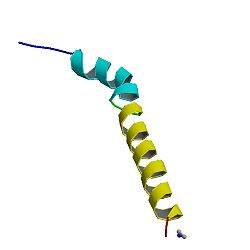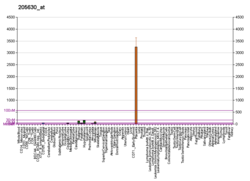Hormone giải phóng Corticotropin
Hormone giải phóng Corticotropin (CRH) (còn được gọi là yếu tố giải phóng corticotropin (CRF) hoặc corticoliberin; corticotropin cũng có thể được đánh vần là corticotrophin) là một hormone peptide liên quan đến phản ứng stress. Nó là một hormone giải phóng thuộc họ yếu tố giải phóng corticotropin. Ở người, nó được mã hóa bởi gen CRH.[3] Chức năng chính của nó là kích thích tổng hợp tuyến yên của ACTH, như là một phần của Trục HPA.
Hormone giải phóng Corticotropin (CRH) là một peptide 41 amino acid có nguồn gốc từ một preprohormone amino acid 196. CRH được tiết ra bởi nhân paraventricular (PVN) của vùng dưới đồi để đáp ứng với căng thẳng. Tăng sản xuất CRH đã được quan sát có liên quan đến bệnh Alzheimer và trầm cảm lớn,[4] và thiếu hụt corticotropin vùng hạ đồi tự phát có nhiều hậu quả chuyển hóa gây tử vong và có thể gây tử vong bao gồm hạ đường huyết.[3]
Ngoài việc được sản xuất ở vùng dưới đồi, CRH còn được tổng hợp trong các mô ngoại biên, như tế bào lympho T, và được biểu hiện cao ở nhau thai. Trong nhau thai, CRH là một dấu hiệu xác định thời gian mang thai và thời gian đẻ và giao hàng. Một sự gia tăng nhanh chóng nồng độ của CRH tuần hoàn xảy ra lúc bắt đầu quá trình sinh đẻ, cho thấy rằng, ngoài các chức năng trao đổi chất của nó, CRH có thể hoạt động như một kích hoạt cho quá trình sinh đẻ.[3]
Một phiên bản tái tổ hợp để chẩn đoán được gọi là corticorelin (INN).
Tác động nội tiết
[sửa | sửa mã nguồn]CRH được sản xuất bởi các tế bào thần kinh nội bào trong nhân tế bào của vùng dưới đồi và được giải phóng tại vị trí trung gian từ các đầu nối thần kinh của các tế bào thần kinh này vào hệ thống mao mạch chính của hệ thống dưới đồi. Hệ thống cổng thông tin mang CRH đến thùy trước của tuyến yên, nơi nó kích thích corticotropes để tiết ra hormone adrenocorticotropic (ACTH) và các hoạt chất sinh học khác (-endorphin). ACTH kích thích sự tổng hợp cortisol, glucocorticoids, mineralocorticoids và DHEA.[5]
Trong ngắn hạn, CRH có thể ngăn chặn sự thèm ăn, tăng cảm giác chủ quan của sự lo lắng và thực hiện các chức năng khác như tăng cường sự chú ý. Mặc dù hành động xa của CRH là ức chế miễn dịch thông qua hoạt động của cortisol, nhưng bản thân CRH thực sự có thể làm tăng viêm, một quá trình đang được nghiên cứu trong nghiên cứu đa xơ cứng.[6]
Kết cấu
[sửa | sửa mã nguồn]Trình tự 41 amino acid của CRH lần đầu tiên được phát hiện trên cừu bởi Vale et al. vào năm 1981.[7] Trình tự đầy đủ của nó là:
- SQEPPISLDLTFHLLREVLEMTKADQLAQQAHSNRKLLDIA
Các peptide chuột và người giống hệt nhau và khác với trình tự của trứng chỉ bởi 7 amino acid.[8]
- SEEPPISLDLTFHLLREVLEMARAEQLAQQAHSNRKLMEII
Vai trò ở động vật không xương sống động vật có vú
[sửa | sửa mã nguồn]Ở động vật có vú, các nghiên cứu cho thấy CRH không có tác dụng thyrotropic đáng kể. Tuy nhiên, trong đại diện của tất cả các động vật có xương sống không có vú, người ta đã phát hiện ra rằng, ngoài chức năng corticotropic, CRH còn có chức năng tuyến giáp mạnh, hoạt động với TRH để kiểm soát trục tuyến giáp (TRH đã được tìm thấy là kém hơn CRH ở một số loài).[9][10]
Tương tác
[sửa | sửa mã nguồn]Hormone giải phóng Corticotropin đã được chứng minh là tương tác với thụ thể hoóc môn giải phóng corticotropin 1.[11][12]
Xem thêm
[sửa | sửa mã nguồn]- Thụ thể hormone giải phóng Corticotropin
- ACTH
- Glucocorticoids
- Proopiomelanocortin
- Trục hypothalamic-tuyến yên-thượng thận
- Hội chứng Cushing
- Bệnh lí Addison
Tham khảo
[sửa | sửa mã nguồn]- ^ a b c GRCh38: Ensembl release 89: ENSG00000147571 - Ensembl, May 2017
- ^ “Human PubMed Reference:”.
- ^ a b c “Entrez Gene: CRH corticotropin releasing hormone”.
- ^ Raadsheer FC, van Heerikhuize JJ, Lucassen PJ, Hoogendijk WJ, Tilders FJ, Swaab DF (tháng 9 năm 1995). “Corticotropin-releasing hormone mRNA levels in the paraventricular nucleus of patients with Alzheimer's disease and depression”. Am J Psychiatry. 152 (9): 1372–6. doi:10.1176/ajp.152.9.1372. PMID 7653697.
- ^ “Corticotrophin-releasing hormone”. ngày 5 tháng 9 năm 2012. Society for Endocrinology. Bản gốc lưu trữ ngày 20 tháng 10 năm 2016. Truy cập ngày 15 tháng 6 năm 2019.
- ^ Paul, William E. (tháng 9 năm 1993). “Infectious Diseases and the Immune System”. Scientific American. 269 (3): 112. Bibcode:1993SciAm.269c..90P. doi:10.1038/scientificamerican0993-90.
- ^ Vale W, Spiess J, Rivier C, Rivier J (tháng 9 năm 1981). “Characterization of a 41-residue ovine hypothalamic peptide that stimulates secretion of corticotropin and beta-endorphin”. Science. 213 (4514): 1394–7. Bibcode:1981Sci...213.1394V. doi:10.1126/science.6267699. PMID 6267699.
- ^ Chrousos GP, Schuermeyer TH, Doppman J, Oldfield EH, Schulte HM, Gold PW, Loriaux DL (tháng 3 năm 1985). “NIH conference. Clinical applications of corticotropin-releasing factor”. Annals of Internal Medicine. 102 (3): 344–358. doi:10.7326/0003-4819-102-3-344. PMID 2982307.
- ^ Seasholtz AF, Valverde RA, Denver RJ (tháng 10 năm 2002). “Corticotropin-releasing hormone-binding protein: biochemistry and function from fishes to mammals”. The Journal of Endocrinology. 175 (1): 89–97. doi:10.1677/joe.0.1750089. PMID 12379493.
- ^ De Groef B, Van der Geyten S, Darras VM, Kühn ER (tháng 3 năm 2006). “Role of corticotropin-releasing hormone as a thyrotropin-releasing factor in non-mammalian vertebrates”. General and Comparative Endocrinology. 146 (1): 62–8. doi:10.1016/j.ygcen.2005.10.014. PMID 16337947.
- ^ Grammatopoulos DK, Dai Y, Randeva HS, Levine MA, Karteris E, Easton AJ, Hillhouse EW (tháng 12 năm 1999). “A novel spliced variant of the type 1 corticotropin-releasing hormone receptor with a deletion in the seventh transmembrane domain present in the human pregnant term myometrium and fetal membranes”. Mol. Endocrinol. 13 (12): 2189–202. doi:10.1210/mend.13.12.0391. PMID 10598591.
- ^ Gottowik J, Goetschy V, Henriot S, Kitas E, Fluhman B, Clerc RG, Moreau JL, Monsma FJ, Kilpatrick GJ (tháng 10 năm 1997). “Labelling of CRF1 and CRF2 receptors using the novel radioligand, [3H]-urocortin”. Neuropharmacology. 36 (10): 1439–46. doi:10.1016/S0028-3908(97)00098-1. PMID 9423932.
Đọc thêm
[sửa | sửa mã nguồn]- Florio P, Severi FM, Ciarmela P, Fiore G, Calonaci G, Merola A, De Felice C, Palumbo M, Petraglia F (2003). “Placental stress factors and maternal-fetal adaptive response: the corticotropin-releasing factor family”. Endocrine. 19 (1): 91–102. doi:10.1385/ENDO:19:1:91. PMID 12583606.
- Florio P, Rossi M, Sigurdardottir M, Ciarmela P, Luisi S, Viganò P, Grasso D, Fiore G, Cobellis L, Di Blasio AM, Petraglia F (2003). “Paracrine regulation of endometrial function: interaction between progesterone and corticotropin-releasing factor (CRF) and activin A”. Steroids. 68 (10–13): 801–7. doi:10.1016/S0039-128X(03)00137-5. PMID 14667971.
- Vamvakopoulos NC, Karl M, Mayol V, Gomez T, Stratakis CA, Margioris A, Chrousos GP (1990). “Structural analysis of the regulatory region of the human corticotropin releasing hormone gene”. FEBS Lett. 267 (1): 1–5. doi:10.1016/0014-5793(90)80272-K. PMID 2365075.
- Robinson BG, D'Angio LA, Pasieka KB, Majzoub JA (1989). “Preprocorticotropin releasing hormone: cDNA sequence and in vitro processing”. Mol. Cell. Endocrinol. 61 (2): 175–80. doi:10.1016/0303-7207(89)90128-7. PMID 2783917.
- Arbiser JL, Morton CC, Bruns GA, Majzoub JA (1988). “Human corticotropin releasing hormone gene is located on the long arm of chromosome 8”. Cytogenet. Cell Genet. 47 (3): 113–6. doi:10.1159/000132525. PMID 3259914.
- Sasaki A, Tempst P, Liotta AS, Margioris AN, Hood LE, Kent SB, Sato S, Shinkawa O, Yoshinaga K, Krieger DT (1988). “Isolation and characterization of a corticotropin-releasing hormone-like peptide from human placenta”. J. Clin. Endocrinol. Metab. 67 (4): 768–73. doi:10.1210/jcem-67-4-768. PMID 3262120.
- Shibahara S, Morimoto Y, Furutani Y, Notake M, Takahashi H, Shimizu S, Horikawa S, Numa S (1984). “Isolation and sequence analysis of the human corticotropin-releasing factor precursor gene”. EMBO J. 2 (5): 775–9. doi:10.1002/j.1460-2075.1983.tb01499.x. PMC 555184. PMID 6605851.
- Behan DP, Heinrichs SC, Troncoso JC, Liu XJ, Kawas CH, Ling N, De Souza EB (1995). “Displacement of corticotropin releasing factor from its binding protein as a possible treatment for Alzheimer's disease”. Nature. 378 (6554): 284–7. Bibcode:1995Natur.378..284B. doi:10.1038/378284a0. PMID 7477348.
- Kawahito Y, Sano H, Mukai S, Asai K, Kimura S, Yamamura Y, Kato H, Chrousos GP, Wilder RL, Kondo M (1996). “Corticotropin releasing hormone in colonic mucosa in patients with ulcerative colitis”. Gut. 37 (4): 544–51. doi:10.1136/gut.37.4.544. PMC 1382908. PMID 7489943.
- McLean M, Bisits A, Davies J, Woods R, Lowry P, Smith R (1995). “A placental clock controlling the length of human pregnancy”. Nat. Med. 1 (5): 460–3. doi:10.1038/nm0595-460. PMID 7585095.
- Slominski A, Ermak G, Hwang J, Chakraborty A, Mazurkiewicz JE, Mihm M (1995). “Proopiomelanocortin, corticotropin releasing hormone and corticotropin releasing hormone receptor genes are expressed in human skin”. FEBS Lett. 374 (1): 113–6. doi:10.1016/0014-5793(95)01090-2. PMID 7589495.
- Sutton SW, Behan DP, Lahrichi SL, Kaiser R, Corrigan A, Lowry P, Potter E, Perrin MH, Rivier J, Vale WW (1995). “Ligand requirements of the human corticotropin-releasing factor-binding protein”. Endocrinology. 136 (3): 1097–102. doi:10.1210/en.136.3.1097. PMID 7867564.
- Vamvakopoulos NC, Chrousos GP (1994). “Structural organization of the 5' flanking region of the human corticotropin releasing hormone gene”. DNA Seq. 4 (3): 197–206. doi:10.3109/10425179309015632. PMID 8161822.
- Perrin MH, Donaldson CJ, Chen R, Lewis KA, Vale WW (1994). “Cloning and functional expression of a rat brain corticotropin releasing factor (CRF) receptor”. Endocrinology. 133 (6): 3058–61. doi:10.1210/en.133.6.3058. PMID 8243338.
- Romier C, Bernassau JM, Cambillau C, Darbon H (1993). “Solution structure of human corticotropin releasing factor by 1H NMR and distance geometry with restrained molecular dynamics”. Protein Eng. 6 (2): 149–56. doi:10.1093/protein/6.2.149. PMID 8386360.
- Liaw CW, Grigoriadis DE, Lovenberg TW, De Souza EB, Maki RA (1997). “Localization of ligand-binding domains of human corticotropin-releasing factor receptor: a chimeric receptor approach”. Mol. Endocrinol. 11 (7): 980–5. doi:10.1210/me.11.7.980. PMID 9178757.
- Timpl P, Spanagel R, Sillaber I, Kresse A, Reul JM, Stalla GK, Blanquet V, Steckler T, Holsboer F, Wurst W (1998). “Impaired stress response and reduced anxiety in mice lacking a functional corticotropin-releasing hormone receptor 1”. Nat. Genet. 19 (2): 162–6. doi:10.1038/520. PMID 9620773.
- Perone MJ, Murray CA, Brown OA, Gibson S, White A, Linton EA, Perkins AV, Lowenstein PR, Castro MG (1998). “Procorticotrophin-releasing hormone: endoproteolytic processing and differential release of its derived peptides within AtT20 cells”. Mol. Cell. Endocrinol. 142 (1–2): 191–202. doi:10.1016/S0303-7207(98)00104-X. PMID 9783915.
- Willenberg HS, Bornstein SR, Hiroi N, Päth G, Goretzki PE, Scherbaum WA, Chrousos GP (2000). “Effects of a novel corticotropin-releasing-hormone receptor type I antagonist on human adrenal function”. Mol. Psychiatry. 5 (2): 137–41. doi:10.1038/sj.mp.4000720. PMID 10822340.
- Saeed B, Fawcett M, Self C (2001). “Corticotropin-releasing hormone binding to the syncytiotrophoblast membranes”. Eur. J. Clin. Invest. 31 (2): 125–30. doi:10.1046/j.1365-2362.2001.00770.x. PMID 11168450.





